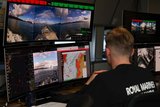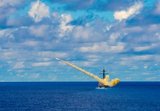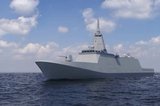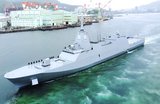Damen introduces MRAV range
Damen has introduced a new range multi-role auxiliary vessels (MRAV) for a range of naval tasks, the company announced on 8 June.
The basic platform is adaptable with supplementary modular mission equipment for various – mainly littoral – naval missions, including explosive ordnance clearance and disposal, diving operations, torpedo recovery and overhaul, ROV and UAV deployment, SAR, coastal infantry and submarine support.
The range of vessels consists of three different designs: the MRAV 660 (43m length), MRAV 1600 (62m length) and MRAV 3600 (85m length).
With a draught of 1.9 metres, the MRAV 660 is suited for very shallow coastal, riverine and inland water operations. It will be positioned for shallow water hydrographic surveys, diving operations, EOCD support, ROV and UAV deployment.
The MRAV 1600 is designed for littoral and regional offshore operations. Its larger size means greater endurance and crew and cargo capacity. In addition to the roles of the MRAV 660 it will be positioned for torpedo recovery and overhaul tasks in support of submarines and anti-submarine warfare units. Small scale coastal transport and infantry support is also possible.
The MRAV 3600 will be capable of operating globally in both littoral and deep waters. It will be configurable for more than one specific mission during a deployment, including serving as a base for disaster and humanitarian relief missions. This vessel also has a helideck and substantial storage capacity for other mission configurations, equipment and cargo.
Piet van Rooij, design and proposal manager, Damen, said: ‘One of Damen’s key aims with this new range of vessels is to reduce the pressure on a navy’s human and financial resources. The modularity of the mission modules also plays a major part in reducing this pressure.
‘We achieved this by combining the capabilities of specialised ships into one ship by using these add-on equipment modules – these can be fitted inside standard 10-, 20- or 40-foot containers or have the footprint of a standard container. When operating multiple ships of the same family and design, the efficiency of training, crew exchangeability and maintenance programmes are improved.’
More from Naval Warfare
-
![NATO tests use of “undetectable, jam-proof” laser communication in maritime scenarios]()
NATO tests use of “undetectable, jam-proof” laser communication in maritime scenarios
As part of its effort to better prepare its capabilities for operations in contested and congested scenarios, NATO evaluated a Lithuanian ship-to-ship terminal designed to not be susceptible to enemy interference.
-
![US Navy advances with the Harpoon Service Life Extension Programme]()
US Navy advances with the Harpoon Service Life Extension Programme
The US Navy plans to improve Harpoon’s anti-ship and land attack capabilities by equipping the missiles with sensors and technologies required for succeeding in future battlespace.
-
![Mitsubishi eyes future with Australia’s Mogami selection]()
Mitsubishi eyes future with Australia’s Mogami selection
With Australia’s selection of the Mogami-class for Project Sea 3000, Mitsubishi is investigating local production in the next decade as potential export opportunities emerge.
-
![Thales’ new Sonar 76Nano could equip UK Royal Navy on anti-submarine warfare missions]()
Thales’ new Sonar 76Nano could equip UK Royal Navy on anti-submarine warfare missions
The new sonar is designed to equip uncrewed underwater vessels, with the potential to be used by the Royal Navy for its Atlantic Bastion and Atlantic Net missions.
-
![Hanwha wins Australian government approval to increase its stake in Austal]()
Hanwha wins Australian government approval to increase its stake in Austal
The contract would mean the two shipbuilders can collaborate strategically and enhance shipbuilding capabilities in Western Australia.























